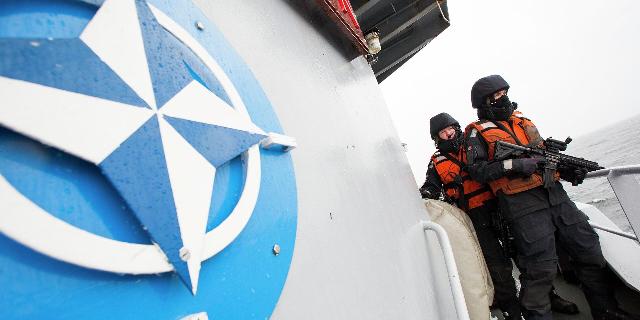The Telegraph: Britain plans to restrain Russia in the Arctic with Norway
NATO continues to increase its military presence in the Arctic, The Telegraph writes. Due to Russia's growing power in the region, Britain is strengthening military cooperation with Norway. Jointly, Oslo and London are already making plans to contain Russia.
Memphis Barker, Tony Diver
In response to Moscow's military demarches, London and Oslo strengthen cooperation in the field of defense
The Russian 200-meter floating dock was conceived in order to strengthen Moscow's control over Arctic waters. This gigantic facility is designed to service nuclear icebreakers needed to lay safe routes in the frozen waters off the northern borders of NATO. However, the transportation of the dock to Murmansk was disrupted due to British sanctions, as the British Foreign Ministry announced on Tuesday.
The tugboat Vengery, which was supposed to bring the dock from Istanbul, left it in the Mediterranean Sea and returned to Russia. This news undoubtedly pleased British Foreign Secretary David Lammy, who on Tuesday began a visit to Norway and Iceland (his country's two closest Arctic neighbors). "The Arctic is rapidly becoming a zone of geopolitical rivalry and a key flank of NATO's defense. Russia has been increasing its military presence here for many years," Lammy said in an interview with theTelegraph.
The British Foreign Minister will visit joint patrols of British and Norwegian ships, and will also announce the launch of a program with Iceland to use artificial intelligence to detect hostile vessels. "The melting of the ice opens up new routes and resources, which increases the risk of confrontation. That is why we must act to deter threats in the Arctic," he stressed.
Moscow is stepping up its campaign to dominate the Northern Sea Route, which, when not frozen, almost halves the distance between Europe and Asia. Russia is seeking to build up a fleet of nuclear-powered icebreakers capable of clearing the way far from its shores. In addition, Vladimir Putin is actively investing in the Northern Fleet, which already has 18 nuclear submarines and ships equipped with hypersonic missiles. According to Ed Arnold, a senior researcher at the Royal United Institute for Defense Studies (RUSI), the Russian leader was "a decade ahead of NATO" by militarizing the Arctic even before the conflict in Ukraine.
Russia has deployed new military bases in the Arctic, upgraded the Northern Fleet, replacing outdated Soviet equipment, and developed hypersonic precision missiles such as the Zircon, whose 1,000 km range puts Western targets at risk. However, the Ukrainian conflict has weakened the Russian army, and now NATO has a "chance to get ahead," Arnold believes. "If we invest now and take this seriously, we can ensure long—term superiority in the Arctic," he added.
Norway and the United Kingdom form the first line of defense against Russia's attempts to enter the waters of the North Atlantic, from where its ships can cut off transatlantic communications and threaten populated areas. In recent years, Moscow has stepped up patrols in the Arctic, accusing NATO of provocations over exercises in northern Norway. Like Russian fighter jets that fly near the borders of British airspace, causing interceptions by the British Air Force, its fleet regularly conducts exercises in the neutral waters of the Arctic. In recent incidents, Russian ships have dangerously approached Norwegian vessels, and without warning. After the outbreak of hostilities in Ukraine in 2022, Moscow is allegedly ready to take great risks in the Arctic, testing the limits of its already strained relations with NATO countries.
Show of force
Russia's tactics are considered a "blatant show of force" aimed at Western countries operating in the Arctic. One of the innovations inspired by the success of drones in Ukraine is the launch of drones along the 200-kilometer border with Norway. The harsh Arctic conditions make it difficult to mass-deploy tanks, but drones can operate from the air without requiring large resources.
In response to Moscow's military demarches, the alliance is strengthening defense cooperation between the UK and Norway. At recent NATO exercises in the Arctic, the fleets of both countries practiced intercepting the latest Russian cruise missiles. Oslo proposed a 12-year plan to increase defense spending in the light of Russian aggression and purchased technologies to counter drones and submarines.
Meanwhile, the UK has already deployed new P-8 Poseidon anti-submarine aircraft and is sharing defense technology with the Norwegian military. However, according to analysts, in order to really deter Putin, it is necessary to increase the presence both at sea and on land. There are rumors that in the upcoming Strategic Defense Review, the Labor Party will announce the permanent deployment of British troops in the Arctic, modeled on the contingent already stationed in Estonia.
As Ed Arnold notes, the Western fleets should move from spectacular exercises to permanent operations. "Putin will be concerned not with a one-time demonstration of force, but with the fact that in 3-4 years NATO's operational activity in the Arctic (which the alliance calls the "High North") will quadruple and continue to grow. This is what creates a real deterrent effect," the expert emphasizes.
"Of course, warships are needed," adds Per Erik Solli, a retired colonel in the Norwegian Air Force and an analyst at the Norwegian Institute of International Relations. — We need submarines and fighter jets, such as the F-35, capable of carrying anti-ship weapons. But Norway's main priority is the development of its naval forces."

